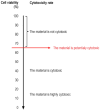Evaluation of Cytotoxicity of the Dental Materials TheraCal LC, TheraCal PT, ApaCal ART and Biodentine Used in Vital Pulp Therapy: In Vitro Study
- PMID: 39195093
- PMCID: PMC11352889
- DOI: 10.3390/dj12080249
Evaluation of Cytotoxicity of the Dental Materials TheraCal LC, TheraCal PT, ApaCal ART and Biodentine Used in Vital Pulp Therapy: In Vitro Study
Abstract
(1) Background: The aim of this study was to compare the cytotoxicity of selected resin-modified materials used in direct contact with the dental pulp (TheraCal LC, TheraCal PT, and ApaCal ART) with calcium silicate cement (Biodentine). (2) Methods: The mouse fibroblast Balb/3T3 cell line and the extracts of tested materials in four concentrations were used for the testing. An MTT assay was performed in three independent experiments with six replicates for each concentration of tested material. The cell viability (%) and cytotoxicity were expressed (cytotoxic effect is considered in cases where the cell viability is lower than 70%). The mean of the cell viability and the standard deviation were expressed for each material at all concentrations. ANOVA and Dunnet's post hoc tests were used for the statistical analysis. All of these tests were performed at the 0.05 significance level. (3) Results: At all concentrations, the cell viability was statistically significantly lower (p ≤ 0.002) for all tested materials compared to Biodentine. ApaCal ART showed a high level of cytotoxicity at all concentrations (cell viability lower than 47.71%, p < 0.0001). The same result was found for TheraCal LC at concentrations of 100%, 50% and 25% and TheraCal PT at concentrations of 100% and 50%. TheraCal LC at a 10% concentration (cell viability 68.18%) and TheraCal PT at a 25% concentration (cell viability 60.63%) indicated potential cytotoxicity. TheraCal PT at a 10% concentration was not found to be cytotoxic (cell viability 79.18%, p = 0.095). (4) Conclusion: The resin-modified calcium silicate and calcium phosphate materials showed higher cytotoxic potential, so they should be used with caution when in direct contact with the dental pulp.
Keywords: MTT assay; calcium phosphate; calcium silicate; cytotoxicity; deep caries; dental pulp; resin-modified; vital pulp treatment.
Conflict of interest statement
The authors declare no conflicts of interest. The authors declare no commercial interests related to the companies involved in this study. The funders had no role in the design of the study; in the collection, analyses, or interpretation of data; in the writing of the manuscript; or in the decision to publish the results.
Figures









References
-
- Duncan H.F., Galler K.M., Tomson P.L., Simon S., El-Karim I., Kundzina R., Krastl G., Dammaschke T., Fransson H., Markvart M., et al. European Society of Endodontology Position Statement: Management of Deep Caries and the Exposed Pulp. Int. Endod. J. 2019;52:923–934. doi: 10.1111/iej.13080. - DOI - PubMed
-
- Wells C., Dulong C., McCormack S. Vital Pulp Therapy for Endodontic Treatment of Mature Teeth: A Review of Clinical Effectiveness, Cost-Effectiveness, and Guidelines. 2019. [(accessed on 18 April 2024)]. Available online: https://www.ncbi.nlm.nih.gov/books/NBK546327/ - PubMed
-
- Novotna B., Harvan L., Somolova L., Morozova Y., Voborna I. Osetreni kazu blizkeho zubni dreni a metoda odlozene exkavace. Czech Dent. J. 2021;121:83–89.
Grants and funding
LinkOut - more resources
Full Text Sources

